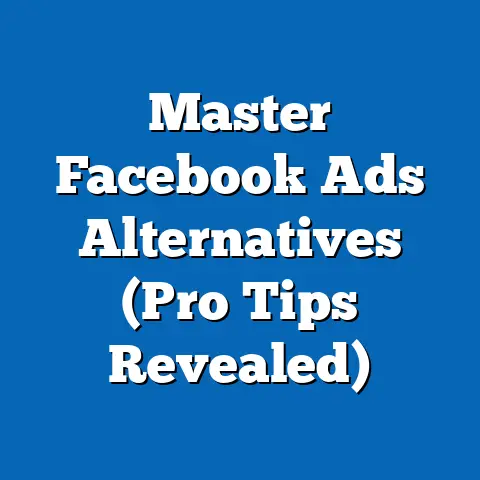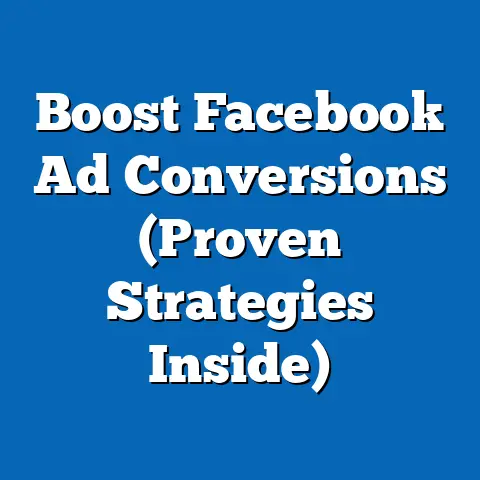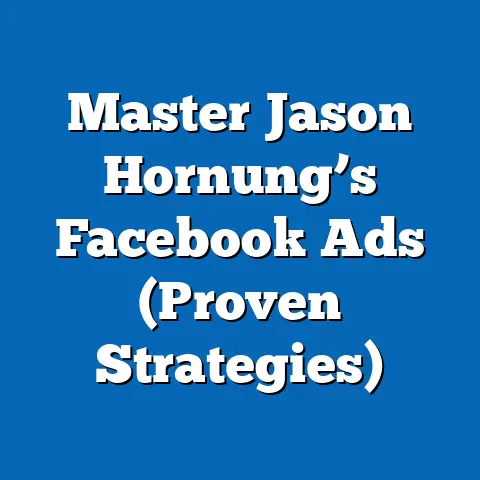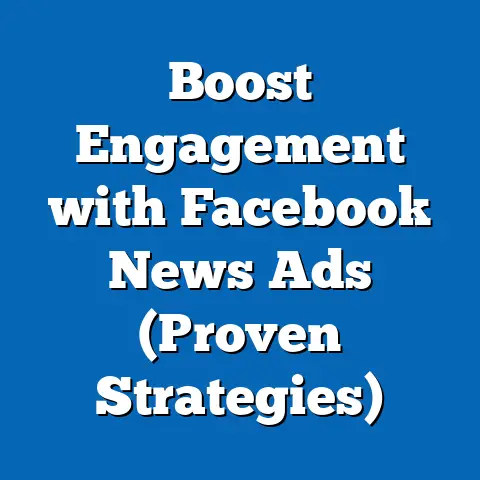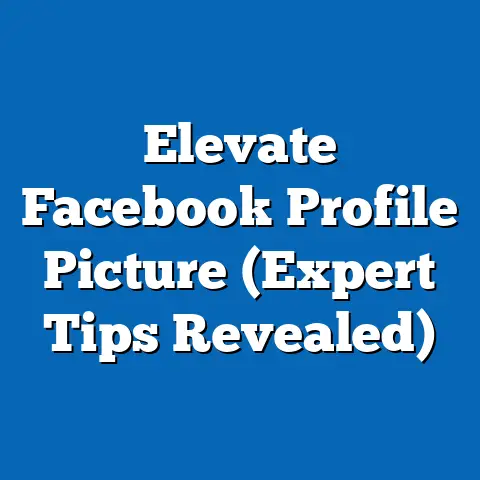Optimize Facebook Ads Budget (Expert Cost Strategies)
Facebook advertising. Just hearing those words can send shivers down the spine of any business owner, especially in a competitive market like North America. I remember when I first started running Facebook Ads for my small online store. I was so excited about the potential reach, but quickly overwhelmed by the sheer number of options and the ever-present fear of burning through my budget without seeing any results. I spent hours poring over articles, watching tutorials, and experimenting with different strategies. It was a steep learning curve, but ultimately, it taught me invaluable lessons about optimizing ad spend and maximizing ROI.
The truth is, Facebook advertising, when done right, is a powerful tool. In North America, with its massive Facebook user base (estimated at over 240 million active users!), the platform offers unparalleled opportunities for businesses to connect with their target audience. According to Statista, digital advertising spend in North America is projected to reach over $300 billion in 2024, with a significant portion allocated to social media platforms like Facebook. However, simply throwing money at ads isn’t enough. You need a strategic approach to budget optimization to truly see a return on your investment.
This article is designed to be your expert guide to navigating the complexities of Facebook Ads budgeting in North America. I’ll share the strategies, tips, and insights I’ve learned over the years, helping you avoid common pitfalls and achieve your advertising goals without breaking the bank. We’ll delve into everything from understanding budgeting options to leveraging A/B testing, all tailored to the unique dynamics of the North American market.
Understanding Facebook Ads Budgeting
Before we dive into advanced strategies, let’s cover the basics. Facebook Ads offers two primary budgeting options: daily budgets and lifetime budgets.
-
Daily Budgets: This allows you to set an average amount you’re willing to spend each day. Facebook will aim to spend close to this amount, but some days it might spend slightly more or less.
-
Lifetime Budgets: With a lifetime budget, you set a total amount you’re willing to spend over the entire duration of your campaign. Facebook will then distribute your budget across the chosen timeframe.
Daily Budgets: This allows you to set an average amount you’re willing to spend each day. Facebook will aim to spend close to this amount, but some days it might spend slightly more or less.
Lifetime Budgets: With a lifetime budget, you set a total amount you’re willing to spend over the entire duration of your campaign. Facebook will then distribute your budget across the chosen timeframe.
Choosing the right option depends on your campaign goals and management style. I often recommend daily budgets for ongoing campaigns where you want consistent performance monitoring and adjustments. Lifetime budgets can be useful for campaigns with a fixed duration, like promoting a specific event or product launch.
The ad objective plays a crucial role in budget allocation. Are you aiming for brand awareness, lead generation, or direct conversions? Each objective requires a different approach. For brand awareness, you might focus on maximizing reach and impressions, which typically involves a lower cost per impression (CPM). For lead generation or conversions, you’ll need to optimize for clicks, leads, or purchases, which might require a higher cost per click (CPC) or cost per acquisition (CPA).
Understanding key terms is essential for effective budgeting.
- Cost Per Click (CPC): The amount you pay each time someone clicks on your ad.
- Cost Per Thousand Impressions (CPM): The amount you pay for every 1,000 times your ad is shown.
- Cost Per Action (CPA): The amount you pay for a specific action, such as a lead submission or a purchase.
These metrics directly impact your budget decisions. If your CPC is too high, you might need to refine your targeting or ad creative. If your CPM is low but your click-through rate (CTR) is also low, you might need to improve your ad relevance.
Takeaway: Understanding the different budgeting options, how they relate to your ad objectives, and key cost metrics is the foundation for effective Facebook Ads budgeting.
Market Analysis and Audience Targeting
North America is a diverse market, and understanding its nuances is crucial for successful Facebook advertising. What works in California might not resonate in New York, and what appeals to Gen Z might not appeal to Baby Boomers. That’s why thorough market analysis and precise audience targeting are essential.
I’ve seen countless campaigns fail simply because the advertiser didn’t take the time to understand their target audience. They assumed they knew what their customers wanted, but their assumptions were wrong.
Tools like Facebook Audience Insights, Google Trends, and third-party market research reports can provide valuable insights into audience behaviors, preferences, and trends in North America.
- Facebook Audience Insights: This tool provides demographic data, interests, and behaviors of your target audience on Facebook. You can use it to identify potential audience segments and refine your targeting.
- Google Trends: This tool shows you what people are searching for online. You can use it to identify trending topics and interests in North America and tailor your ad copy accordingly.
- Market Research Reports: Companies like Nielsen, Statista, and Forrester offer detailed reports on consumer behavior and market trends in North America. These reports can provide valuable insights into your target audience.
Creating precise audience segments based on demographic data, interests, and behaviors is key to maximizing your ad spend. Consider factors like age, gender, location, education, income, relationship status, and interests. You can also target people based on their purchase behavior, website activity, and mobile app usage.
For example, if you’re selling organic baby food, you might target parents aged 25-45 in affluent neighborhoods with an interest in healthy eating and natural products. You could also target people who have recently purchased baby products online or visited websites related to parenting.
Cultural nuances can significantly influence ad performance. North America is a melting pot of cultures, and understanding these cultural differences is essential for creating ads that resonate with your target audience. For example, using inclusive language, representing diverse ethnicities, and being mindful of cultural sensitivities can improve ad performance and build brand loyalty.
Takeaway: Invest time in understanding your target audience in North America. Use market analysis tools, create precise audience segments, and be mindful of cultural nuances to maximize your ad spend and improve ad performance.
Setting Realistic Goals and KPIs
Before you launch your Facebook Ads campaign, it’s crucial to set realistic advertising goals that align with your overall business objectives. What do you want to achieve with your advertising? Are you aiming to increase brand awareness, generate leads, drive sales, or improve customer engagement?
I’ve seen many businesses fail because they didn’t have clear goals in mind. They simply launched ads without a specific objective, and as a result, they didn’t know what to measure or how to optimize their campaigns.
In North America, where competition is fierce, setting specific, measurable, achievable, relevant, and time-bound (SMART) goals is essential.
- Specific: Clearly define what you want to achieve. For example, “Increase website traffic by 20% in the next quarter.”
- Measurable: Define how you will measure your success. For example, “Track website traffic using Google Analytics.”
- Achievable: Set goals that are realistic and attainable. Don’t set yourself up for failure by setting unrealistic expectations.
- Relevant: Ensure your goals align with your overall business objectives.
- Time-bound: Set a deadline for achieving your goals.
Key performance indicators (KPIs) are metrics that track your progress towards your goals. Some of the most relevant KPIs for Facebook advertising success include:
- Reach: The number of unique people who saw your ad.
- Impressions: The number of times your ad was displayed.
- Click-Through Rate (CTR): The percentage of people who clicked on your ad after seeing it.
- Conversion Rate: The percentage of people who completed a desired action after clicking on your ad, such as making a purchase or filling out a form.
- Cost Per Click (CPC): The amount you pay each time someone clicks on your ad.
- Cost Per Acquisition (CPA): The amount you pay for a specific action, such as a lead submission or a purchase.
- Return on Ad Spend (ROAS): The amount of revenue you generate for every dollar you spend on advertising.
Tailor your goals and KPIs to the unique characteristics of the North American market. Consider factors like the competitive landscape, customer expectations, and economic conditions. For example, if you’re launching a new product in a highly competitive market, you might focus on increasing brand awareness and driving website traffic. If you’re targeting a niche market with high-value products, you might focus on generating leads and driving sales.
Takeaway: Set realistic goals and KPIs that align with your business objectives and the unique characteristics of the North American market. Track your progress regularly and adjust your campaigns as needed.
Bidding Strategies for Cost Efficiency
Facebook offers various bidding strategies that allow you to control how much you pay for your ads. Understanding these strategies and choosing the right one for your campaign objectives is crucial for cost efficiency.
I’ve seen many advertisers waste money by using the wrong bidding strategy. They might be using manual bidding when automatic bidding would be more effective, or vice versa.
The two main bidding strategies are manual bidding and automatic bidding.
- Manual Bidding: This allows you to set the maximum amount you’re willing to pay for each click or impression. You have more control over your bids, but it requires more monitoring and adjustments.
- Automatic Bidding: This allows Facebook to automatically set your bids based on your campaign objectives and budget. It’s less work for you, but you have less control over your bids.
When to use each strategy depends on your campaign objectives and budget constraints. I generally recommend automatic bidding for beginners or for campaigns with a large budget. It allows Facebook to optimize your bids based on its vast data and machine learning algorithms. However, for more experienced advertisers or for campaigns with a limited budget, manual bidding can be more effective. It allows you to fine-tune your bids and target specific audiences or placements.
Here are some examples of successful bidding strategies implemented by North American businesses:
- A clothing retailer used manual bidding to target a specific audience segment with high purchase intent. They set a maximum CPC of $1.00 and were able to generate a ROAS of 4:1.
- A software company used automatic bidding to maximize reach and impressions. They set a daily budget of $100 and were able to reach over 100,000 people in their target market.
- A local restaurant used cost cap bidding to ensure they never paid more than a certain amount for a conversion. This allowed them to acquire new customers at a predictable cost.
Takeaway: Understand the different bidding strategies available on Facebook and choose the right one for your campaign objectives and budget constraints. Experiment with different strategies and monitor your results to optimize your cost efficiency.
Continuous Monitoring and Adjustment
Facebook advertising is not a “set it and forget it” activity. It requires continuous monitoring and adjustment to ensure you’re getting the best possible results. I’ve learned this the hard way. I remember launching a campaign that performed well for the first few days, but then quickly started to decline. I didn’t monitor it closely enough, and as a result, I wasted a significant portion of my budget.
In North America, where the market is constantly evolving, continuous monitoring is even more critical.
Tools like Facebook Ads Manager, Google Analytics, and third-party analytics platforms can help you track ad performance in real-time. Pay attention to metrics like reach, impressions, CTR, conversion rate, CPC, CPA, and ROAS.
If you notice that your ads are not performing as well as expected, don’t be afraid to make adjustments. Here are some common adjustments you can make:
- Refine your targeting: If your ads are not reaching the right people, refine your targeting criteria.
- Improve your ad creative: If your ads are not engaging, try different headlines, images, or videos.
- Adjust your bidding strategy: If your CPC or CPA is too high, try a different bidding strategy.
- Pause underperforming ads: If some of your ads are performing poorly, pause them and focus on the ones that are working.
- Reallocate your budget: If some of your ads are performing better than others, reallocate your budget to those ads.
I’ve found that making small, incremental adjustments is often more effective than making drastic changes. Test different variations of your ads and targeting, and monitor the results closely.
Takeaway: Continuously monitor your ad performance and make adjustments as needed to optimize your results. Don’t be afraid to experiment and try new things.
Leveraging A/B Testing for Cost Optimization
A/B testing, also known as split testing, is a powerful technique for optimizing your Facebook Ads and improving your budget allocation. It involves creating two or more versions of an ad and testing them against each other to see which one performs better.
I’ve used A/B testing to significantly improve the performance of my Facebook Ads campaigns. It allows you to identify the most effective ad copy, visuals, targeting options, and bidding strategies.
Here’s a step-by-step guide on how to set up effective A/B tests:
- Define your hypothesis: What do you want to test? For example, “A headline with a question will generate more clicks than a headline with a statement.”
- Create two or more versions of your ad: Change only one variable at a time. For example, test different headlines, images, or targeting options.
- Set up your A/B test in Facebook Ads Manager: Use the “Split Test” feature to create your test.
- Run your test for a sufficient amount of time: Make sure you have enough data to draw meaningful conclusions.
- Analyze your results: Identify the winning ad variation.
- Implement the winning variation: Use the winning ad variation in your campaigns.
- Repeat the process: Continuously test different variables to optimize your ads.
Variables to test include:
- Ad copy: Test different headlines, descriptions, and calls to action.
- Visuals: Test different images, videos, and ad formats.
- Targeting options: Test different audience segments, interests, and behaviors.
- Bidding strategies: Test different bidding strategies, such as manual vs. automatic bidding.
- Placements: Test different ad placements, such as Facebook Feed, Instagram Feed, and Audience Network.
Here are some real-world examples of North American businesses that have successfully used A/B testing to lower costs and improve ad performance:
- A SaaS company used A/B testing to test different ad headlines. They found that a headline with a specific benefit generated 30% more clicks than a headline with a general statement.
- An e-commerce store used A/B testing to test different product images. They found that an image with a model using the product generated 20% more sales than an image of the product alone.
- A local bakery used A/B testing to test different targeting options. They found that targeting people with an interest in baking generated 15% more leads than targeting people with an interest in food.
Takeaway: Leverage A/B testing to optimize your Facebook Ads and improve your budget allocation. Test different ad copy, visuals, targeting options, and bidding strategies to identify the most effective combinations.
Conclusion
Optimizing your Facebook Ads budget in North America requires a strategic approach that combines a deep understanding of the platform, the market, and your target audience. By implementing the expert cost strategies outlined in this article, you can maximize your ROI and achieve your advertising goals without breaking the bank.
Remember, Facebook advertising is an ongoing process of learning, testing, and optimizing. Stay up-to-date with the latest trends and best practices, and don’t be afraid to experiment and try new things.
The potential for businesses in North America to see significant returns by applying these strategies is immense. The key is to be proactive, data-driven, and adaptable. The digital marketing landscape is constantly evolving, and businesses must continually adapt and optimize their advertising strategies to stay ahead of the competition.
Call to Action:
I encourage you to share your experiences with Facebook Ads budgeting in the comments below. What strategies have worked for you? What challenges have you faced? And if you’re looking for tailored advice or services to help you optimize your campaigns effectively, feel free to reach out! I’m always happy to help businesses in North America achieve their advertising goals.

